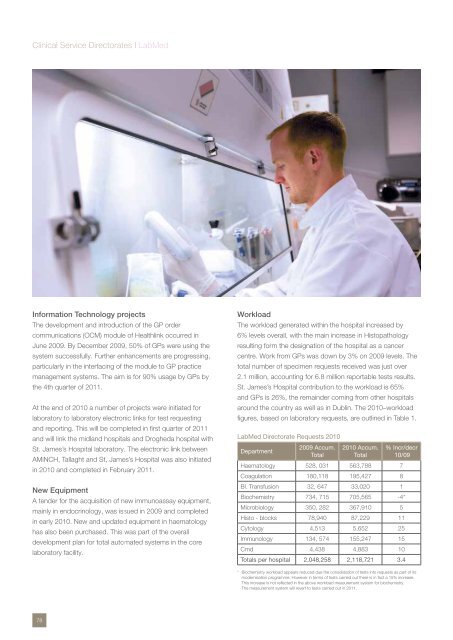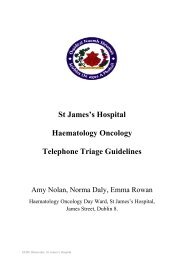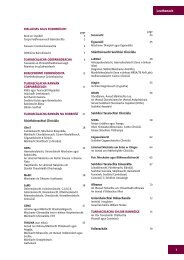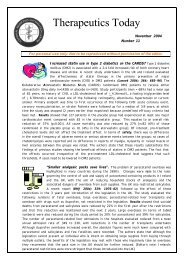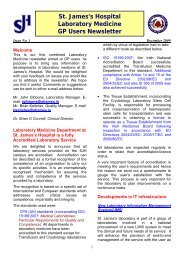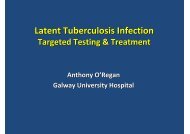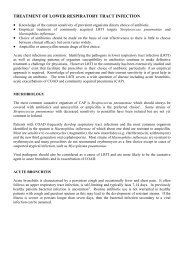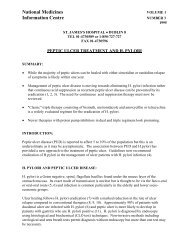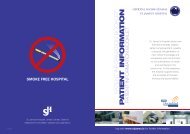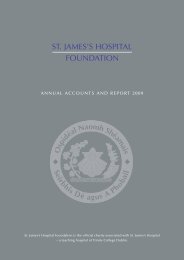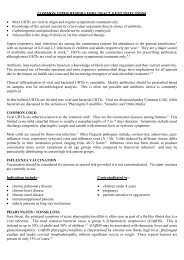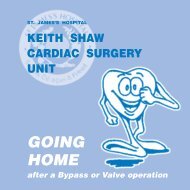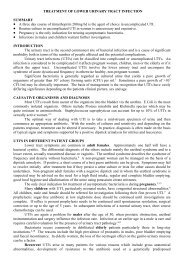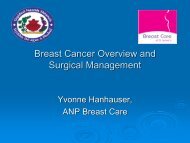Annual Report 2010 - St. James's Hospital
Annual Report 2010 - St. James's Hospital
Annual Report 2010 - St. James's Hospital
Create successful ePaper yourself
Turn your PDF publications into a flip-book with our unique Google optimized e-Paper software.
Clinical Service Directorates I LabMed<br />
Information Technology projects<br />
The development and introduction of the GP order<br />
communications (OCM) module of Healthlink occurred in<br />
June 2009. By December 2009, 50% of GPs were using the<br />
system successfully. Further enhancements are progressing,<br />
particularly in the interfacing of the module to GP practice<br />
management systems. The aim is for 90% usage by GPs by<br />
the 4th quarter of 2011.<br />
At the end of <strong>2010</strong> a number of projects were initiated for<br />
laboratory to laboratory electronic links for test requesting<br />
and reporting. This will be completed in fi rst quarter of 2011<br />
and will link the midland hospitals and Drogheda hospital with<br />
<strong>St</strong>. James’s <strong>Hospital</strong> laboratory. The electronic link between<br />
AMiNCH, Tallaght and <strong>St</strong>, James’s <strong>Hospital</strong> was also initiated<br />
in <strong>2010</strong> and completed in February 2011.<br />
New Equipment<br />
A tender for the acquisition of new immunoassay equipment,<br />
mainly in endocrinology, was issued in 2009 and completed<br />
in early <strong>2010</strong>. New and updated equipment in haematology<br />
has also been purchased. This was part of the overall<br />
development plan for total automated systems in the core<br />
laboratory facility.<br />
Workload<br />
The workload generated within the hospital increased by<br />
6% levels overall, with the main increase in Histopathology<br />
resulting form the designation of the hospital as a cancer<br />
centre. Work from GPs was down by 3% on 2009 levels. The<br />
total number of specimen requests received was just over<br />
2.1 million, accounting for 6.8 million reportable tests results.<br />
<strong>St</strong>. James’s <strong>Hospital</strong> contribution to the workload is 65%<br />
and GPs is 26%, the remainder coming from other hospitals<br />
around the country as well as in Dublin. The <strong>2010</strong>–workload<br />
fi gures, based on laboratory requests, are outlined in Table 1.<br />
LabMed Directorate Requests <strong>2010</strong><br />
Department<br />
2009 Accum.<br />
Total<br />
<strong>2010</strong> Accum.<br />
Total<br />
% Incr/decr<br />
10/09<br />
Haematology 528, 031 563,788 7<br />
Coagulation 180,118 195,427 8<br />
Bl. Transfusion 32, 647 33,020 1<br />
Biochemistry 734, 715 705,565 -4*<br />
Microbiology 350, 282 367,910 5<br />
Histo - blocks 78,940 87,229 11<br />
Cytology 4,513 5,652 25<br />
Immunology 134, 574 155,247 15<br />
Cmd 4,438 4,883 10<br />
Totals per hospital 2,048,258 2,118,721 3.4<br />
* Biochemistry workload appears reduced due the consolidation of tests into requests as part of its<br />
modernisation programme. However in terms of tests carried out there is in fact a 15% increase.<br />
This increase is not refl ected in the above workload measurement system for biochemistry.<br />
The measurement system will revert to tests carried out in 2011.<br />
78


